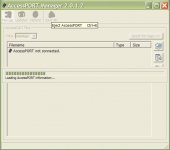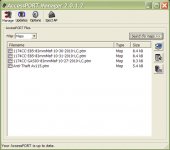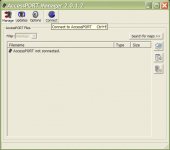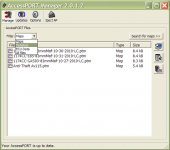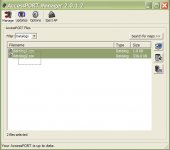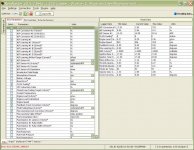What does it all mean and how do I share...
How Do I Interpret the data.
It is actually subjective as to what you are actually seeing in a log file because different issues can cause similar results. So it is the recommendation to post your logs and let us pick it apart to deliberate a suggestion. I will also say at this moment that a log will not always reveal a problem. For that it is highly recommended that you employ some old fashioned mechanical tests that can either prove or disprove a problem...
- The first test you can perform is a compression test. This test will reveal a broken ring landing or a cracked, bent, or broken valve or a cracked head or head gasket.
- The second is a leak down test. This test will confirm a leaky valve or head gasket or worn rings.
- Do a boost leak test of the intake system
- The last but most overlooked test is a simple vacuum test of the intake manifold. This test can tell you allot about how the car is breathing. It can confirm all of the problems listed above.
It is also recommended to take a reference log and confirm it is good and keep it for future reference. This way if the performance of your car deteriorates over time you can compare current logs to the original and make better determinations as to what is wrong. It is also recommended you find the same stretch of road or a planned route to use every time you log to rule out variations in load, grade, elevation, etc.
One more thing to understand is that though your log may change over time this may not indicate a problem at all. The ECU is constantly adjusting itself according to its environment and variables such as temperature, humidity, atmospheric pressure and elevation have a profound effect on the tune and subsequently the log
Now lets see if we can read some of the data and put it into perspective.
Fueling
Immediately you want to focus on one thing. Fueling. If your fuel is not correct then it will throw off everything else. You want to take your logs during both closed loop and open loop operations. That means you want to drive around normally with smooth throttle input and then include one or two WOT runs in Third and Fourth gear.
In Closed Loop operation (Cruising), observe both your Long and Short term fuel trims together (A/F Correction and A/F Learned). You want to look at the SUM of the two together. Positive numbers mean the ECU is adding fuel to compensate for leaner than stoich or ideal conditions and Negative numbers mean the ECU is taking away fuel to compensate for richer than stoich or ideal conditions. However this does not mean you are running lean or rich. It is simply an indication of the adjustments the ECU is making to achieve a stoich condition. The AFR is an indication of whether the car is running rich or lean. In my opinion it is better to see more negative over positive numbers in your fuel trims but as long as your fuel trims don't exceed 10% most of the time, your fueling is probably okay. Ideally you will want the SUM of your short and long term trims to be less than +/-6%. It is normal to see spikes in the readings. This is usually do to the effects of Tip-in Enrichment during the opening of the throttle plate. You will see corresponding spikes in both fuel trims and AFR as it relates to throttle position. This is why we recommend smooth throttle input during logging.
Open loop logging is best done when combined with a stand alone Wide Band AFR gauge. This will give you the most accurate readings because the ECU does not reference the OEM AFR sensor. Open Loop fueling references the MAF sensor and the Primary Fuel Target tables with in the ecu's programming. The OEM AFR sensor will still output a reading but the ECU will not take it into consideration. Typically the OEM lambda sensor is limited to about 11:1 give or take but is not at all accurate. This is why a stand alone AFR gauge is required. You need to know the precise AFR the vehicle is running during WOT and if your real world results correspond to the values dictated in the primary fuel table.
Things to look for in good fueling are,
- Consistent fuel trims throughout the MAF curve (range of driving).
- Fuel trims that are less than a total of +/-10% and ideally fluctuating between positive and negative numbers.
- Small variations due to Tip-in Enrichment. Large variations generally means a poorly tuned map and can be the reason for knock during the onset of throttle.
Bad fueling examples would be,
- Wildly fluctuating fuel throughout the MAF curve. Usually means a poorly tuned map or a bad MAF or AFR sensor. Cleaning the MAF can often help with this issue
- Fuel trims that are high or low at one end of the MAF curve and in the opposite direction at the other end. This usually means poorly tuned map and that possibly your fuel injector latency is off.
- Consistently high fuel trim and AFR. Usually means, but not limited to, a leak in the intake after the MAF sensor but before the turbo.
- High fuel trims and AFR at idle and cruise but rich at WOT. This generally points to a boost leak somewhere after the turbo. This is often associated with stumbling or lose of power. Look at fuel in conjunction with boost.
- Fuel trims are either rich or lean as compared to a stand alone Wide Band. This can indicate a bad AFR sensor.
- The log says you are running lean and fuel trims are high BUT the wide band says you are running very rich. This indicates a bad O2 Sensor.
Timing
This is where things can get complicated because it is sometimes difficult to interpret whether a knock event is bad or whether it is knock at all. For example if you have a built motor with noisy forged internals you may experience knock events that occur largely in the same place all the time and no matter how much timing you remove from those spots it never goes away. Another example would be very low load and low RPM knock events. These are not damaging events and I tend to ignore these most of the time unless it is excessive. It is perfectly normal to experience this kind of event. Even a stock tune can exhibit some knock. It is the level or intensity of knock you should be concerned with or whether it is consistent.
Also just because you see the ECU pulling timing in a specific column, that doesn't automatically mean that it is a bad event. You need to look at the Whole Picture when interpreting the log for knock. You need to observe the base timing and total timing together. The total timing is the sum of all timing compensations. This means that the ECU will look at Base Timing and add Knock Correction (FBKC), Learned Knock (FLKC) and Dynamic Advance (Knock Correction Advance) and other timing compensations to derive total timing. Ultimately the ECU will try to achieve the highest possible timing and, in some cases, approach the threshold of knock. The moment it hears knock it will back off just below the threshold. You can see this in the following example...
Base Timing = 26*
Ignition Advance = 4*
FBKC = -2*
FLKC = 0*
Total Timing = 28*
So you can see by this example that even though 2* of timing is being pulled from the FBKC column, Ignition Advance is still adding 4* thereby making your total timing greater than base timing. This is ok provided it is not happening under significant load. In situations that result in a total timing less than base timing generally indicates an interesting knock event and probably should be looked into.
You should also note that because you see timing being pulled in the Learned Knock (FLKC) column, this does not mean that a knock event occurred specifically. This column is pulling timing base on history. This only means that at some point recently, there was knock in that particular place and it happened more that a few times so the ECU is pulling timing in the event it happens again. If over time, the knock in that area subsides, the ECU will reset learned data and apply the appropriate timing. However, you should definitely address any knock that is observed in the learned knock column.
Knock intensity is of concern when timing being pulled is more than -2* and consistent over time. For example if I see only two or three lines were 3* of timing is being pulled and this occurs at random interval, I probably will just note it and possibly address it later if I observe knock in the same area again. But, if I see it pulling 3* from several lines of data and it occurs at the same time most of the time then I would be very concerned and this is something that I would address immediately.
Another interesting event would be when timing is pulled and then suddenly more timing is pulled. This generally indicates a true knock event because the ECU first heard some knock and applied a correction. That correction was not enough to subside the knock so the ECU pulled more timing until it heard none.
Another example of an interesting event is during high load and WOT conditions. Any kind of observed knock is not desired IMO. Regardless of base timing versus total timing, any observed knock should be addressed.
Now also look at your timing and fuel together. If you are getting knock in certain areas also take into consideration the amount of fuel that is being delivered. Too lean a fuel mixture can cause knock so you want to observe the AFR both during the knock event and prior to. But consider this also... Too much fuel can cause knock also. The key is to find the ideal AFR vs load/rpm.
Boost
Boost is relatively straight forward. The log is relative to Target Boost and Waste Gate Duty Cycle tables and other compensations in the ECU. By logging Boost (Manifold Relative Pressure), WGDC and Turbo Dynamics (Boost Error) you can determine how much the ECU is adjusting to achieve target boost. For example lets assume your target boost for a given RPM and Throttle position is 18psi, ideally when you see a row corresponding to that rpm and throttle position in your log, you will want to see something close to 18psi. However; there are many other factors involved to derive the final boost pressure like load, atmospheric pressure, temperature and so on, so don't be discouraged if you find that you are not hitting target in a specific gear. The turbo derives its output first and fore most from load and engine speed. If you are WOT in first or second gear you will almost NEVER reach target. In third and fourth you will either hit your target or come very close. In fifth and sixth gear you may likely over shoot your target. This is because the load on the engine increases significantly as you progress through the gears. That said you will want to log for boost in third or fourth gears WOT to see if you are nearing your target.
If you are not reaching your target, Turbo Dynamics (Boost Error) will give you a good indication of how much you are off. This number represents the amount of adjustment the ECU is making to the waste gate to try to achieve target boost. Negative numbers mean you are over shooting your target and positive numbers mean you are under shooting your target. These values are an error represented in PSI. So if Turbo Dynamics reports a 3 PSI error, that means the ECU will increase WGDC to try to achieve 3 PSI more of boost. This function only works as well as you define turbo dynamics tables. For most after market turbo application, the stock turbo dynamic tables will definitely need to be adjusted to achieve the best desired results. You can easily achieve target in nearly every gear if you know how to adjust these tables properly.
How Do I Post a Log
The best method is to post your logs using Google Docs and simply link to it. Remember when doing this, to make your files public so we can view them with out having to enter a user name and password.

